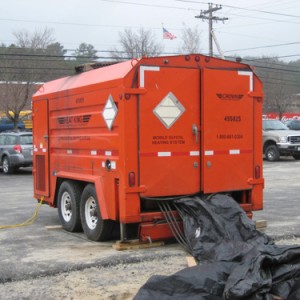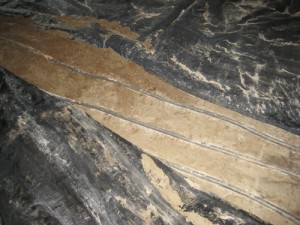How To Remove Ground Frost Before Mother Nature
Deep Ground Frost
 Here in New England it’s not uncommon to find frost over 4 feet in the ground after a long cold winter. Before building a foundation all of the frost has to be removed from the sub-grade. You can let mother nature do the work and wait weeks or even months for the ground to thaw or you can remove it physically.
Here in New England it’s not uncommon to find frost over 4 feet in the ground after a long cold winter. Before building a foundation all of the frost has to be removed from the sub-grade. You can let mother nature do the work and wait weeks or even months for the ground to thaw or you can remove it physically.
If you don’t remove the frost and you then build a foundation on top of the frozen ground you’ll face some serious problems. Once the ground thaws the structure will begin to settle and move. The structure will most likely be exposed to structural stresses that cause cracking and failure. So it’s absolutely imperative that the frost be removed prior to building the foundation.
Methods To Remove Ground Frost
There are several methods to physically remove the ground frost. We typically use two different methods depending on the depth of frost and area that needs to be corrected. If the frost isn’t all that deep and the area is relatively small the frost can be dug out of the ground using large excavators and earth moving equipment. Otherwise we use mobile ground heaters to help speed up the thawing process and drive the frost out of the ground.
Mobile Ground Heater
 We use mobile ground heaters to thaw out deep ground frost over large areas. Mobile ground heaters are a rather simple piece of equipment that’s very similar to household boilers used to heat homes. The mobile trailer has a large oil or propane fired boiler, large fuel tanks and a large coil of rubber hose filled with hot water.
We use mobile ground heaters to thaw out deep ground frost over large areas. Mobile ground heaters are a rather simple piece of equipment that’s very similar to household boilers used to heat homes. The mobile trailer has a large oil or propane fired boiler, large fuel tanks and a large coil of rubber hose filled with hot water.
To thaw out the ground in a particular area the rubber tubing is rolled out on the ground spaced about 8 to 12 inches apart. The ground is then covered with insulating blankets. You can see an example in the adjacent photo showing the tubing and blankets. Then the boiler is started up and hot water circulates through the tubing. Typically the ground heater can remove about 6 inches of frost every 24 hours. So if you have 4 feet of frost it can take 8 days or more to completely thaw the ground.
Obviously this is not a cheap way of doing things. This particular piece of equipment cost $7500 per month to rent plus fuel! However, when time is of the essence this is the way to go. The important thing to realize is if you’re building in the winter or spring be sure you dig test pits. Be sure the frost is gone before you start building so you don’t run into problems later.













When you need to get in the ground in the winter, a ground-thaw heater can’t be beat! Radiators (with electric fans) can also be hooked up to the hoses for doing liquid to air heating of enclosed spaces. We had to use it on an emergency call one Christmas day to thaw out the sewage treatment plant in town.
You probably run something besides water in the lines right? Glycol or some other anti-freeze liquid.
We run Glycol in the lines.
When we’re pouring a slab that has radiant heat in it, our concrete sub hooks up his ground heater to the header and heats the slab while they pour it. Helps for a great cure during the winter.
We are trying to get the frost out of the ground in Minnesota. We have a building that is 60X90 and 24X40 all attached together. We are getting a Frost Fighter 1.5M BTU Heater. Will this get the frost out of the ground? And if it will work how long do you think it would take?
Thank you
Jeremy – I assume you’re talking about a “torpedo” heater correct? If so….you’ll be there a VERY long time. You need to rent a ground heater.
Hi Todd,
In your opinion, how much(depth) frost can you draw out of the ground via this method? Been a harsh winter in the midwest (I’m in IA). Is 4′ realistic? Also, do you recommend any minimum temp (day of pour or following) that you would want for pouring a slab (ex: basement or garage)?
Thanks!~!
Casey – Yes, 4′ of frost can be removed with this type of equipment. In some situations, flooding the sub-grade after the first couple feet of frost is removed can drastically speed up the last couple of feet. Not sure about a minimum temp, but we typically keep the sub-grade heated and remove the heat the morning of the pour so it’s never an issue.
Thanks for the reply Todd. RE: temp – I was just referring to air temps and minimums for pouring a floor. Have heard engineers say want it at least 34F and rising for pouring flat surfaces… but just wanted another opinion.
Thanks again for your insight!
Ahh….well that really depends on the contractor. I have a very good concrete sub that does floors for us. We typically put temporary heat in the garage/building while they pour, usually about 40 degrees inside and things go well.
Hi Todd,
I might be starting a 12×24 kitchen/living room bump out in loudon NH. I have use this system before in laconia working on the collage addition with BPS. I would like to get an idea of cost to rent the system before I talk to the homeowner. Do you rent it by the week or is it a one month minimum?
One of my workers thinks we might be able to break ground if we plow the snow and start to dig the same day. Do you think that might be possable? His theory was that the snow insulates the ground so it won’t be that frozen and we might be able to dig without de-thawing?
I’d apperate any thoughts you have on this!
Also do you provide the blankets?
Thanks
Michael S Twamley
M S Twamley Exteriors
1-603-545-2869
Michael – We don’t rent ours out. We built this one because the cost to rent them was getting too expensive. I’d call United Rentals and they will quote a price to rent one. Don’t forget the price of fuel too!
In many places with snow cover the frost can be limited and excavation can happen, but it’s a case by case situation. Good luck!
Todd,
I am interested in building my own ground heater. Any assistance you can offer would be appreciated.
Basically we took an old oil boiler, the trailer has the boiler, an oil tank, and then we have a power hose real (ones that go in oil delivery trucks), then a long rubber hose. You have to run glycol in it, and have a decent size pump for the long hose.
Great information here learned a lot. We are about 90% done with our 50’x72’x16’ pole barn (non insulated) and have frost about 1 foot down and want to pour our concrete slab ASAP. We plan to rent a ground heater and as you know they are expensive. Have you tried running the ground heater 1hour on 1 hour off to help keep the hour meter down (our rental charges 8 hrs as a day)
It’s all about energy input….that will just take longer to get the job done in my opinion. 1 foot of frost should come put pretty quickly if you put enough frost blankets over it.